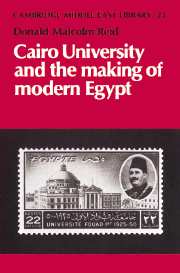Book contents
- Frontmatter
- Contents
- List of illustrations
- List of tables
- Acknowledgments
- Note on academic terminology and transliteration
- List of abbreviations
- Introduction
- Part I The private university, 1908–1919
- Part II The university and the liberal ideal, 1919–1950
- Part III In Nasser's shadow, 1950–1967
- Part IV The university since Nasser
- 12 The open door and the Islamist challenge
- Conclusion and prospect
- Notes
- Select bibliography
- Index
12 - The open door and the Islamist challenge
Published online by Cambridge University Press: 30 October 2009
- Frontmatter
- Contents
- List of illustrations
- List of tables
- Acknowledgments
- Note on academic terminology and transliteration
- List of abbreviations
- Introduction
- Part I The private university, 1908–1919
- Part II The university and the liberal ideal, 1919–1950
- Part III In Nasser's shadow, 1950–1967
- Part IV The university since Nasser
- 12 The open door and the Islamist challenge
- Conclusion and prospect
- Notes
- Select bibliography
- Index
Summary
The breeze of infitah, President Sadat's “open door,” wafted through Cairo University as well as the national economy, polity, and society. There were hints of infitah in Nasser's last three years, but it took Sadat's purge of his Nasserist rivals in 1971 and the October War of 1973 to clear the way for major changes in foreign and domestic policy. Sadat abandoned the Soviet Union for the United States as superpower patron, drew close to conservative Saudi Arabia in return for financial support, and made a peace treaty with Israel when other Arab states refused to follow. But the Israeli treaty broke the nascent Saudi-Egyptian alignment, forced Egypt into complete financial dependency on the US, and isolated her diplomatically from the Arab world. In the economic sphere to which the term “infitah” primarily applied, Sadat opened Egypt to foreign trade and investment, encouraged private enterprise while retaining the large public sector, and tried to satisfy the urban poor with subsidies on basic commodities and the affluent with imported luxury goods. First Sadat and then Mubarak experimented with a freer press, a more independent judiciary, and opposition parties. At the universities, the return to election of three candidates for dean, the abolition for a time of the university guard, and the easing of restrictions on student activities symbolized the “opening.”
- Type
- Chapter
- Information
- Cairo University and the Making of Modern Egypt , pp. 215 - 230Publisher: Cambridge University PressPrint publication year: 1990



